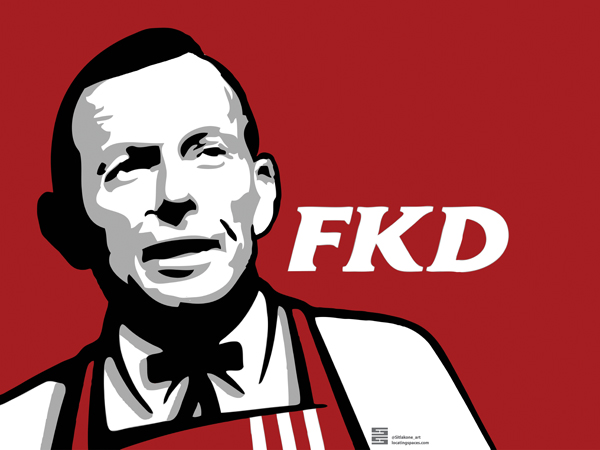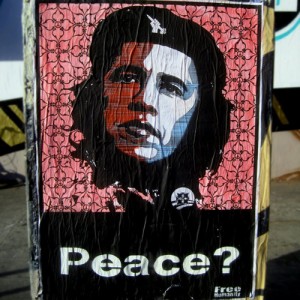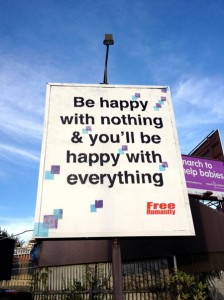Politically inspired images are nothing new in the street art scene.
They appeared in Russia when locals voiced their frustrations at President Putin’s leadership and in Greece, where many artists protested the global financial crisis.
Street art has gained some notoriety for its presence in political campaigns such as Barack Obama’s candidacy for President of the United States and it’s further been used to unify Egyptian women and children to promote social justice and women’s rights.
Recently, Afghanistan’s first female street artist, Shamsia Hassani, spoke to Art Radar Asia about her drive to illustrate that art is stronger than war. During the past two years, street art has also become a new wave of expression for locals in Saudi Arabia and Kuwait.
It has gained media attention most recently in the Egyptian uprising and around the controversy with whistleblower, Edward Snowden.
Whatever the content, there is no denying street art can provoke political debate.
Recently, Sydney based artist Sittoula Sitlakone caused a stir of reactions with his politically provocative Tony Abbott FKD piece.
The image of Tony Abbott parodying Colonel Sanders from KFC with the words FKD next to it was witnessed around Australian cities, during the lead up to the recent federal election.

Sitlakone believes politically provocative art is a beneficial way to get a message across.
“As much as we don’t like to have the usual ads shoved in our faces, people tend to have a personal experience with provocative art. When it’s done well it just grabs and pulls you in,” Sitlakone says.
Responses from the Abbott FKD piece Sitlakone says, has all been positive.
“People have similar views about Mr Abbott,” he says.
“I’ve had artists ask permission to reproduce the image and many people have also ordered posters. I’ve also seen people using the image as their profile picture on social networking sites.”
The infamous image has made Sitlakone a finalist in the Stencil Art Prize which launches on 16 October at the Chrissie Cotter Gallery in Sydney.
Sitlakone’s motivations for producing the image were nothing short than provocative.
“A lot of things Mr Abbott stands for seems to be all backwards. He doesn’t even support his own sister in gay rights. I don’t think he’s competent enough to lead our country – it’s all F**K*D,” he says.
Also known for being politically outspoken is Los Angeles-based artist Free Humanity,
Free believes street art can – and should – inspire social, cultural and political change.
[liveblog][oqeygallery id=56][liveblog]
Growing up an avid skater in Los Angeles, the urban artist says the streets of LA inspired him to be a positive influence on others with his Free Humanity message.
Beginning his campaign in 2009, Free believes art can instil or plant seeds of humanity through awareness of self and social issues.
“This is what I strive for in all my work,” he says.
The spiritual artist’s signature style embodies thought provoking, positive and political art.
Free says he wants people to unite as a community in love and peace, instead of succumbing to greed and power.
One of the earliest works he created was the iconic Chebama piece.
Chebama, an image of US President Barack Obama overlapping the infamous image of revolutionary leader Che Guevara, was produced in 2009 when Obama won the Nobel Peace Prize.
Despite the political inspiration of his work, Free insists public art has a duty to educate the public.
“To me art should inform, delight and enlighten. Passion for every day and love for humanity are the reasons why I make art. People’s reactions to my work are mostly very positive, but there are always haters. You can’t please everybody.”
One of Free’s most inspiring pieces illustrates the quote: “Be happy with nothing and you’ll be happy with everything.”
He says the thought provoking quote signifies that “grateful people are happy people”.
Sourcing inspiration from the struggles and hurdles in life, Free says even if it means being political, “it’s important to promote equal rights and justice for all humans and animals”.
Whether it generates thought-provoking opinion or not, politically provocative inspired street art won’t be getting scrubbed anytime soon.
The official Free Humanity website can be found here, Facebook, Instagram & Flickr.
Follow Sittoula Sitlakone’s work here or on Twitter.
Mandi Santic is a third year Bachelor of Journalism student at La Trobe University, and a staff writer for upstart. You can follow her on Twitter: @candidmandi
Images (c) Free Humanity
Image (c) Sittoula Sitlakone









